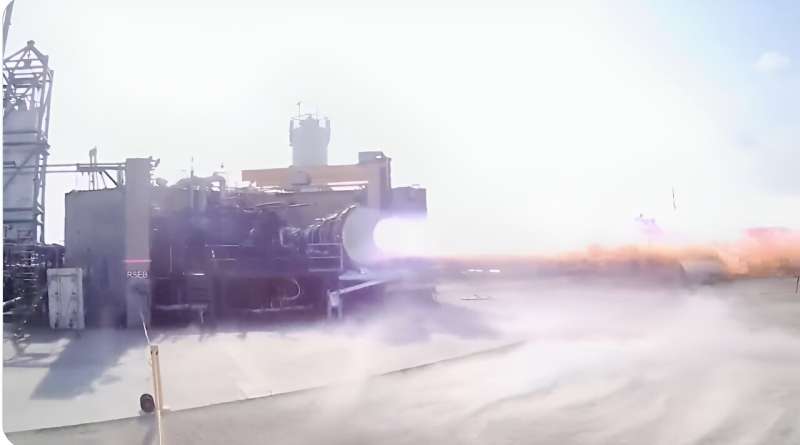This article has been reviewed according to Science X's editorial process and policies. Editors have highlighted the following attributes while ensuring the content's credibility:
fact-checked
trusted source
proofread
SpaceX test fires a Raptor engine, simulating a lunar landing

When NASA astronauts return to the surface of the moon in the Artemis III mission, the plan is to use a modified SpaceX Starship as their lunar lander. NASA announced last week that SpaceX has now demonstrated an important capability of the vacuum-optimized Raptor engine that will be used for the lander: an extreme cold start.
A test last month successfully confirmed the engine can be started in the frigid conditions of space, even when the vehicle has spent an extended time in space, where temperatures will drop lower than a shorter low-Earth orbit mission. The Raptor vacuum engine was chilled to mimic conditions after a long coast period in space, and then was successfully fired.
SpaceX has a video on X (formerly Twitter) showing the test firing.
NASA said that one challenge that differentiates Artemis missions from those in low Earth orbit is that the landers may sit in space without firing for an extended period of time, "causing the temperature of the hardware to drop to a level below what they would experience on a much shorter low Earth orbit mission."
SpaceX signed a $2.89 billion contract with NASA to develop a human landing system (HLS) for Artemis 3, currently scheduled to land astronauts on the moon in 2025. Also, SpaceX signed another $1.15 billion contract last year for Artemis 4, which will tentatively take place 2028.
Artemis 2 is the second scheduled mission of NASA's Artemis program and the first scheduled crewed mission of NASA's Orion spacecraft, currently planned to be launched by the Space Launch System (SLS) in November 2024. However, several indications point to that flight being delayed.
The Starship HLS will be powered by two variants of the company's Raptor engines—one optimized to operate in atmospheric pressure at sea-level and one optimized to operate in space, or in a vacuum, where there is no atmosphere.
SpaceX had previously tested that the engine could handle the descent portion of the mission, firing continuously for 281 seconds, the approximate amount of time for a descent burn to the lunar surface. That test, in November 2021 also showed Raptor's ability to change the level of engine power over time, called the throttle profile, and for the engine to burn the full length of time of the powered descent phase. NASA said that successful test provided NASA "with early confidence in the company's engine development."
For Artemis III, the Starship HLS will land crew members at a region near the lunar South Pole to conduct moonwalks and survey the likely area of a future moon base. SpaceX says on future missions, Starship will deliver supplies, equipment, and science payloads needed for extensive surface exploration.
Like any space hardware, testing critical technologies and hardware under simulated and actual flight conditions is key. On April 20, 2023, SpaceX conducted the first integrated launch of Starship and the Super Heavy booster, the most powerful rocket to ever launch. However, after liftoff, the vehicle experienced several anomalies including the loss of multiple first-stage engines. After the second stage failed to separate from the first stage, the vehicle's flight termination system was activated.
SpaceX's Raptor engines will next be put to the test during the company's second integrated flight test of Starship and Super Heavy; the schedule for that test is currently not known.
Provided by Universe Today





















